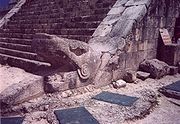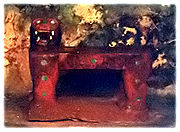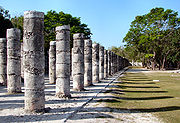Chichen Itza (pronounced
/tʃiːˈtʃɛn iːˈtsɑː/;[1]
from
Yucatec Maya:
Chi'ch'Ëen Ãitsha',[2]
"At the mouth of the well of the
Itza") is a large
pre-Columbian
archaeological site built by the
Maya civilization located in the northern center
of the
Yucat·n Peninsula, in the
Yucat·n state, present-day
Mexico.
Chichen Itza was a major regional
focal point in the northern Maya lowlands from the
Late Classic through the
Terminal Classic and into the early portion of
the
Early Postclassic period. The site exhibits a
multitude of architectural styles, from what is
called ìMexicanizedî and reminiscent of styles seen
in central Mexico to the
Puuc style found among the Puuc Maya of the
northern lowlands. The presence of central Mexican
styles was once thought to have been representative
of direct migration or even conquest from central
Mexico, but most contemporary interpretations view
the presence of these non-Maya styles more as the
result of
cultural diffusion.
The ruins of Chichen Itza are
federal property, and the siteís stewardship is
maintained by Mexicoís
Instituto Nacional de AntropologÌa e Historia (National
Institute of Anthropology and History, INAH).
The land under the monuments, however, is
privately-owned by the Barbachano family.[3]
Name and orthography

Feathered Serpent, bottom of "El
Castillo" staircase
The Maya name "Chich'en Itza"
means "At the mouth of the well of the Itza." This
derives from chi', meaning "mouth" or "edge",
and ch'e'en, meaning "well." Itz· is the name
of an ethnic-lineage group that gained political and
economic dominance of the northern peninsula. The
name is believed to derive from the Maya itz,
meaning "magic," and (h)·, meaning "water."
Itz· in Spanish is often translated as "Brujas del
Agua (Witches of Water)" but a more precise
translation would be Magicians of Water.[citation
needed]
The name is often represented as
ChichÈn Itz· in
Spanish and when translated into other languages
from Spanish to show that both parts of the name are
stressed on their final syllables. Other references
prefer to employ a more rigorous
orthography in which the word is written
according to
Maya language, using Chich'en Itz·
(pronounced
[tʃitʃʼen its·ʔ]. This form preserves the
phonemic distinction between ch' and
ch, since the base word ch'e'en (which,
however, does have a neutral tone vowel "e" in Maya
and is not accented or stressed in Maya) begins with
a
glottalized affricate. The word "Itz·'" has a
high rise final "a" that is followed by a
glottal stop (indicated by the apostrophe).
There is evidence in the
Chilam Balam books that there was another,
earlier name for this city prior to the arrival of
the Itza hegemony in northern Yucat·n. This name is
difficult to define because of the absence of a
single standard of orthography, but it is
represented variously as Uuc Yabnal,[4]
Uuc Hab Nal,
[5] or Uc Abnal.
[6] While most sources agree the first
word means seven, there is considerable debate as to
the correct translation of the rest. Among the
translations suggested are ìSeven Bushes,î ìSeven
Great Houses,î or ìSeven Lines of Abnal.î
History
Northern Yucat·n is arid, and the
rivers in the interior all run underground. There
are two large, natural sink holes, called
cenotes, that could have provided plentiful
water year round at Chichen, making it attractive
for settlement. Of the two cenotes, the "Cenote
Sagrado" or
Sacred Cenote (also variously known as the
Sacred Well or Well of Sacrifice), is the most
famous. According to post-Conquest sources (Maya and
Spanish), pre-Columbian Maya sacrificed objects and
human beings into the cenote as a form of worship to
the Maya rain god
Chaac.
Edward Herbert Thompson dredged the Cenote
Sagrado from 1904 to 1910, and recovered artifacts
of
gold,
jade,
pottery, and
incense, as well as human remains.[7]
A recent study of human remains taken from the
Cenote Sagrado found that they had wounds consistent
with human sacrifice.[8]

Kukulcan's Jaguar Throne, interior
temple of "El Castillo"
Ascendancy
Chichen Itza rose to regional
prominence towards the end of the
Early Classic period (roughly 600 AD). It was,
however, towards the end of the
Late Classic and into the early part of the
Terminal Classic that the site became a major
regional capital, centralizing and dominating
political, sociocultural, economic, and ideological
life in the northern Maya lowlands. The ascension of
Chichen Itza roughly correlates with the decline and
fragmentation of the major centers of the southern
Maya lowlands, such as
Tikal.
Some
ethnohistoric sources claim that in about 987 a
Toltec king named
Topiltzin Ce Acatl Quetzalcoatl arrived here
with an army from central Mexico, and (with local
Maya allies) made Chichen Itza his capital, and a
second
Tula. The art and architecture from this period
shows an interesting mix of Maya and Toltec styles.
However, the recent re-dating of Chichen Itza's
decline (see below) indicates that Chichen Itza is
largely a Late/Terminal Classic site, while Tula
remains an Early Postclassic site (thus reversing
the direction of possible influence).
Political
organization

Columns in the Temple of a Thousand
Warriors
Several archaeologists in late
1980s suggested that unlike previous Maya polities
of the Early Classic, Chichen Itza may not have been
governed by an individual ruler or a single
dynastic
lineage. Instead, the cityís political
organization could have been structured by a "multepal"
system, which is characterized as rulership through
council composed of members of
elite ruling lineages.[9]
This theory was popular in the 1990s, but in recent
years, the research that supported the concept of
the "multepal" system has been called into question,
if not discredited. The current belief trend in Maya
scholarship is toward the more traditional model of
the Maya kingdoms of the Classic southern lowlands.[10]
Economy
Chichen Itza was a major economic
power in the northern Maya lowlands during its
apogee. Participating in the water-borne
circum-peninsular trade route through its port site
of
Isla Cerritos, Chichen Itza was able to obtain
locally unavailable resources from distant areas
such as central Mexico (obsidian)
and southern
Central America (gold).
Decline
According to Maya chronicles
(e.g., the Book of
Chilam Balam of Chumayel), Hunac Ceel, ruler of
Mayapan, conquered Chichen Itza in the 13th
century. Hunac Ceel supposedly prophecized his own
rise to power. According to custom at the time,
individuals thrown into the Cenote Sagrado were
believed to have the power of prophecy if they
survived. During one such ceremony, the chronicles
state, there were no survivors, so Hunac Ceel leaped
into the Cenote Sagrado, and when removed,
prophecized his own ascension.
While there is some
archaeological evidence that indicates ChichÈn Itz·
was at one time looted and sacked,[11]
there appears to be greater evidence that it could
not have been by Mayapan, at least not when ChichÈn
Itz· was an active urban center. Archaeological data
now indicates that Chichen Itza fell by around AD
1000, some two centuries before the rise of Mayapan.[12]
Ongoing research at the site of Mayapan may help
resolve this chronological conundrum.
While ChichÈn Itz· ìcollapsedî
(meaning elite activities ceased and the site
rapidly depopulated) it does not appear to have been
completely abandoned. According to post-Conquest
sources, both Spanish and Maya, the
Cenote Sagrado remained a place of pilgrimage.
Spanish
arrival
In 1526
Spanish
Conquistador
Francisco de Montejo (a veteran of the Grijalva
and CortÈs expeditions) successfully petitioned the
King of Spain for a charter to conquer Yucat·n. His
first campaign in 1527, which covered much of the
Yucat·n peninsula, decimated his forces but ended
with the establishment of a small fort at
Xaman Ha', south of what is today
Canc™n. Montejo returned to Yucat·n in 1531 with
reinforcements and took
Campeche on the west coast. He sent his son,
Francisco Montejo The Younger, in late 1532 to
conquer the interior of the Yucat·n Peninsula from
the north. The objective from the beginning was to
go to ChichÈn Itz· and establish a capital.[13]
Montejo the Younger eventually
arrived at Chichen Itza, which he renamed Ciudad
Real. At first he encountered no resistance, and set
about dividing the lands around the city and
awarding them to his soldiers. The Maya became more
hostile over time, and eventually they laid siege to
the Spanish, cutting off their supply line to the
coast, and forcing them to barricade themselves
among the ruins of ancient city. Months passed, but
no reinforcements arrived. Montejo the Younger
attempted an all out assault against the Maya and
lost 150 of his remaining forces. He was forced to
abandon ChichÈn Itz· in 1534 under cover of
darkness. By 1535, all Spanish had been driven from
the Yucat·n Peninsula.[14]
Montejo eventually returned to
Yucat·n and conquered the peninsula. The Spanish
crown later issued a land grant that included
Chichen Itza and by 1588 it was a working cattle
ranch.[15]